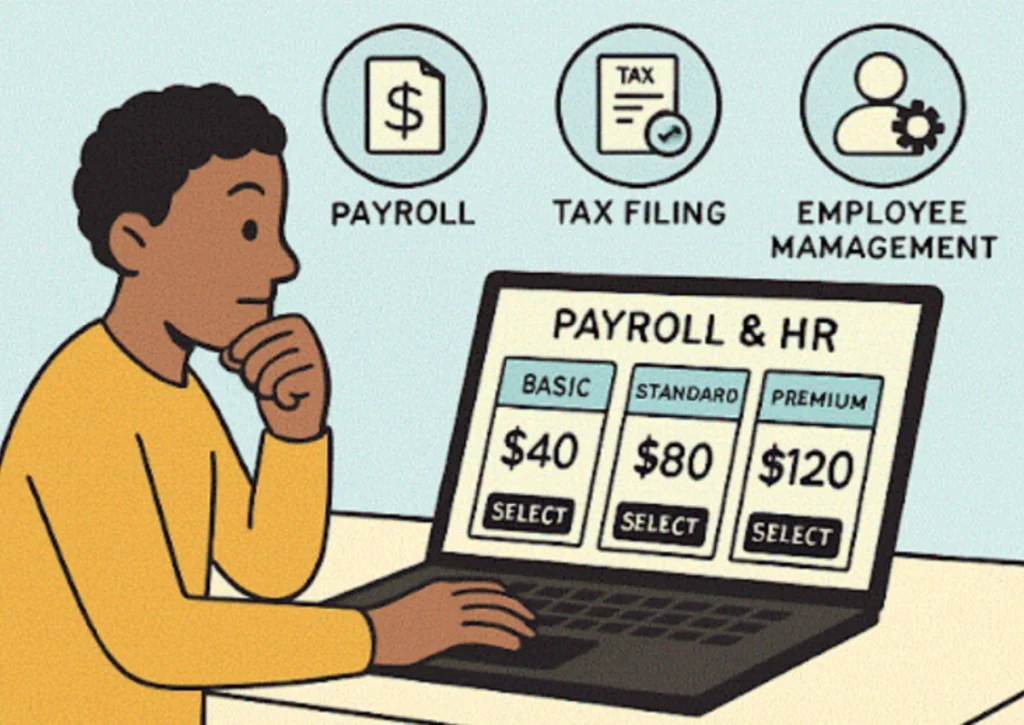Table of Contents
- Understanding Payroll VCX nd HR Platforms for Small Businesses
- Standard Pricing Models for Payroll and HR Services
- Typical Costs and Fees Small Businesses Might Encounter
- Factors That Influence Payroll and HR Platform Pricing
- Hidden Costs and How to Avoid Them
- Comparing Providers: What Matters Most Besides Price
- HR and Payroll Pricing Trends That Dominate the Industry
- Easy Steps in Selecting the Payroll and HR System Choices
- Conclusion
Understanding Payroll VCX nd HR Platforms for Small Businesses
Payroll and HR platforms have emerged as vital equipment for small groups in search of to streamline back-office operations, improve accuracy, and focus on growth. These structures simplify complicated obligations such as revenue calculations, tax compliance, worker benefits management, onboarding, and more. With time-consuming office work and ever-changing felony requirements, small business proprietors more and more rely upon technology to deal with payroll and HR capabilities efficiently.
The right platform offers a lot more than simply paycheck processing; it boosts compliance, tracks break day, integrates with accounting software programs, and helps fast growth with the aid of scaling with commercial enterprise needs. Transparency in pricing is crucial for making knowledgeable selections. For a strong understanding of payroll pricing transparency, reviewing how prices are based and disclosed gives owners the readability needed to evaluate carriers optimistically.
A sturdy payroll and HR machine does more than keep the lights on. It guarantees felony compliance, fosters worker belief via reliable payment and benefits delivery, and liberates business owners from repetitive administrative burdens. These structures can be the distinction between a reactive, error-prone manner and a proactive, easily running commercial enterprise infrastructure.
As your agency grows, so do the complexities of hard work laws and compliance. Investing in a scalable payroll and HR solution ensures that you stay agile, regardless of how regulations change or your crew grows.
Standard Pricing Models for Payroll and HR Services
Pricing for payroll and HR services varies, with most companies providing subscription models, pay-in keeping with-use alternatives, or charges based on the range of personnel. Subscription plans generally involve a fixed monthly price, plus per-employee charges, covering core capabilities along with payroll processing, popular reviews, and limited support. Pay-in keeping with-use options may be appropriate for groups with occasional payroll desires, at the same time as consistent with-worker charges increase as your team grows.
To explore detailed pricing structures for SMB HR software, starting from basic plans at just $2 in step with user in keeping with month, to complete packages with recruiting, payroll, benefits, and personalized support, see the HR Software Pricing Guide by using Forbes Advisor.
Carefully reviewing these alternatives allows commercial enterprise owners to set healthy fees with the exact level of service they want. Taking the time to evaluate plans can in the long run store money at the same time as ensuring the right guide for long-term growth.
Commonly, the base price covers payroll processing, direct deposits, tax calculations, and primary reporting. However, vital offerings, including tax filings, 12-month paperwork, or unique reporting, may additionally incur additional prices. Understanding these distinctions permits owners to manage finances greater correctly and avoid unexpected fees.
It’s critical to scrutinize now not just charge tags, but also what’s protected. Will you need add-ons for time monitoring, advantages administration, or included HR tools? Knowing what’s general vs. Greater is vital for price forecasting and selecting the right healthy.

Typical Costs and Fees Small Businesses Might Encounter
While in search of a payroll or HR platform, small companies ought to be prepared for several distinct fees:
- Setup and Implementation Fees: One-time expenses for onboarding your industrial corporation to the new device, migrating data, and preliminary configuration. These vary from nominal fees to several hundred greenbacks, depending on complexity and issuer.
- Monthly Service Fees: Core costs that cowl platform access, regularly blended with in keeping with-employee or in keeping with-payroll charges.
- Additional Costs: These may also consist of quarterly and annual tax filings, W-2/1099 education, off-cycle payroll runs, garnishment processing, or top-rate customer service. Some structures offer these à la carte, while others package them into higher-tier plans.
Budgeting for the “whole picture” prevents surprises at year-end and guarantees your HR and payroll answers provide a dependable price.
Factors That Influence Payroll and HR Platform Pricing
Several critical factors determine what you’ll pay for a payroll and HR platform:
- Number of Employees and Payroll Frequency: More staff or common paychecks normally result in higher expenses, particularly if services are billed consistently with employee or on a per-run basis.
- Assiduity-Specific: Regulations Businesses in unexpectedly regulated diligence frequently bear customized compliance results, which could affect general freight.
- Position of Customization and Integration: Integrating with being account or HR systems, or taking acclimatized workflows, regularly incurs a redundant figure.
- Additional Features: HR compliance equipment, onboarding modules, advanced analytics, and a committed guide can increase the charge; however additionally add significant cost and protection.
Hidden Costs and How to Avoid Them
Owners often face hidden prices that could erode their budget and belief. Examples consist of prices for historical payroll facts migration, obligatory year-end form processing, or higher-than-anticipated fees for multi-state tax filing. To keep away from such surprises:
- Carefully evaluate contracts and service agreements. Look for sections categorised ‘additional offerings,’ ‘top class capabilities,’ or ‘termination clauses.
- Ask direct questions on all possible redundant freight, such as client support situations, software program upgrades, and compliance adaptations.
Comparing Providers: What Matters Most Besides Price
Although value is crucial, it shouldn’t be the best consideration. Users enjoy—how easy, short, and dependable the software feels impacts productivity and allows you to save mistakes. Exceptional customer service can cope with troubles directly, fending off payroll delays or unfavourable worker considerations. Additionally, record safety and compliance are vital, specifically while coping with sensitive employee data and adhering to regulations.
HR and Payroll Pricing Trends That Dominate the Industry
Small business payroll and HR services are evolving rapidly. The upward thrust of integrated HR platforms—protecting payroll, benefits, compliance, and employee engagement affords greater convenience and competitive pricing. These innovations enable small corporations to get access to superior functions cheaply, permitting proprietors to recognition much less on administrative responsibilities and more on strategic planning and growth. Be on the lookout for structures imparting modular pricing, AI-pushed compliance tracking, and bendy integrations.
Easy Steps in Selecting the Payroll and HR System Choices
Selecting the right solution doesn’t just depend upon headline charges. Use this tick list to assess your options:
- Define your crucial necessities (payroll, blessings, onboarding, compliance, integrations).
- Request complete value breakdowns, such as extra offerings and future scale.
- Assess software program usability and demo systems if possible.
- Compare customer service rules and response times.
- Review protection certifications and compliance guarantees.
- Consult with a payroll expert or commercial enterprise consultant for tailor-made guidance.
A platform that suits your finances, streamlines operations, protects your records, and grows with your business enterprise is the first-rate funding you could make.
Also Read: Why Custom Invitations Still Matter (And How to Make Yours Stand Out)
Conclusion
Payroll and HR systems have emerged as indispensable equipment for small corporations, providing some distance more than just basic payroll processing. They streamline compliance, reduce administrative burdens, and beautify worker agreement with on the same time as assisting scalability as a business grows. While charge remains a vast issue, it is equally essential to weigh transparency, capabilities, consumer experience, and customer service.
Understanding fashionable pricing fashions, not unusual prices, and hidden prices ensures proprietors can make knowledgeable and assured choices. By carefully comparing desires, evaluating carriers, and considering each instantaneous and long-term fee, small companies can choose a platform that not simplest fits their budget but also empowers them to consciousness on sustainable growth and strategic priorities.


